Discover 11 hidden attractions, cool sights, and unusual things to do in Chaco Culture National Historical Park (United States). Don't miss out on these must-see attractions: Chetro Ketl, Pueblo Bonito, and Fajada Butte. Also, be sure to include Casa Rinconada in your itinerary.
Below, you can find the list of the most amazing places you should visit in Chaco Culture National Historical Park (New Mexico).
Table of Contents
Chetro Ketl
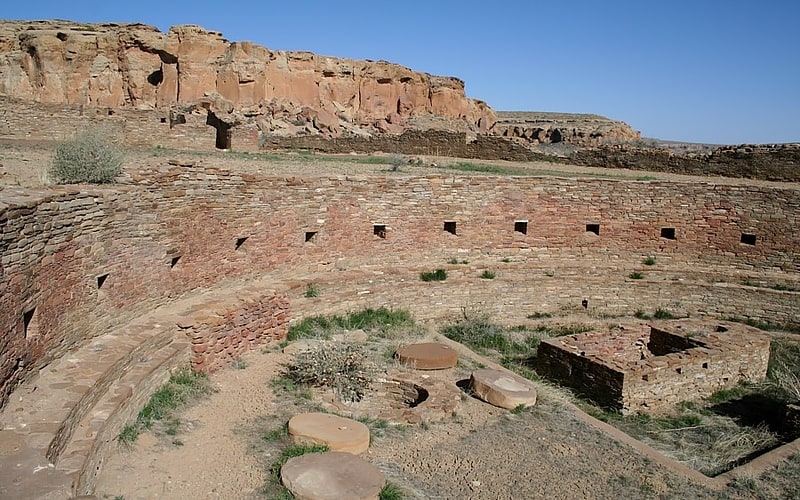
Archaeological site in San Juan County, New Mexico. Chetro Ketl is an Ancestral Puebloan great house and archeological site located in Chaco Culture National Historical Park, New Mexico, United States. Construction on Chetro Ketl began c. 990 and was largely complete by 1075, with significant remodeling occurring in the early and mid-1110s. Following the onset of a severe drought, most Chacoans emigrated from the canyon by 1140; by 1250 Chetro Ketl's last inhabitants had vacated the structure.
The great house was rediscovered in 1823 by the Mexican governor of New Mexico, José Antonio Vizcarra, and in 1849 Lieutenant James Simpson of the United States Army Corps of Engineers documented the major ruins in Chaco Canyon. Edgar L. Hewett, the director of the first archeological field school in the canyon, conducted excavations of Chetro Ketl during 1920 and 1921, and again between 1929 and 1935.
Chaco scholars estimate that it required more than 500,000 man-hours, 26,000 trees, and 50 million sandstone blocks to erect Chetro Ketl. The great house is a D-shaped structure; its east wall is 280 feet (85 m) long, and the north wall is more than 450 feet (140 m); the perimeter is 1,540 feet (470 m), and the diameter of the great kiva is 62.5 feet (19.1 m). Chetro Ketl contained approximately 400 rooms and was the largest great house by area in Chaco Canyon, covering nearly 3 acres (1.2 ha). Chetro Ketl lies 0.4 miles (0.64 km) from Pueblo Bonito, in an area that archeologists call downtown Chaco; they theorize that the area may be an ancestral sacred zone. Chetro Ketl contains architectural elements, such as a colonnade and tower kiva, that appear to reflect a Mesoamerican influence.
Chetro Ketl's purpose is widely debated but many archeologists believe the building was a place of large-scale ceremony that held an important position within the larger Chacoan system. It may have been occupied primarily by groups of priests and, during times of ritual, pilgrims from outlying communities. Archeologist Stephen H. Lekson believes Chetro Ketl was a palace inhabited by Chacoan royalty, and the scale of its construction was motivated by what architects call "massing": building imposing structures with the intent to impress onlookers. The building has deteriorated significantly since its rediscovery in the early 19th century, and its usefulness as a source of information about Chacoan culture is slowly diminishing.[1]
Address: Chaco Culture National Historical Park, 87037 Nageezi
Pueblo Bonito
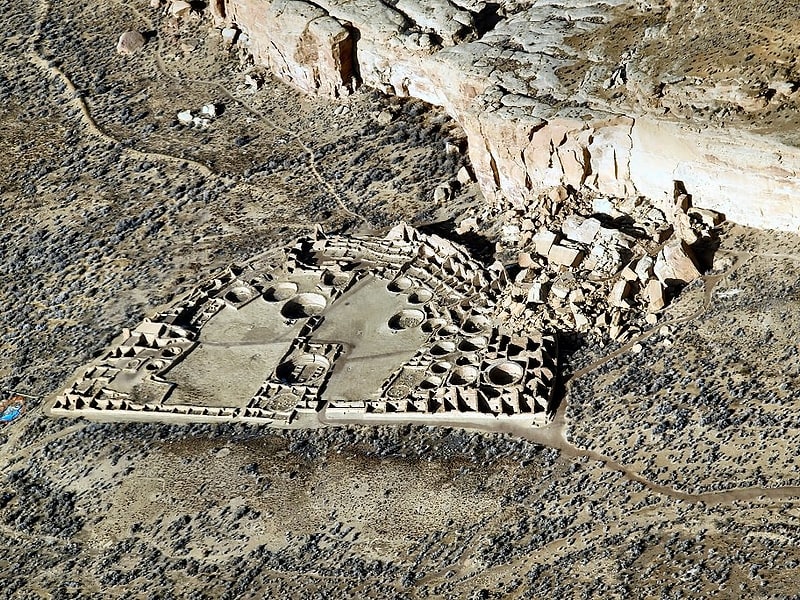
Archaeological site in San Juan County, New Mexico. Pueblo Bonito is the largest and best-known great house in Chaco Culture National Historical Park, northern New Mexico. It was built by the Ancestral Puebloans who occupied the structure between AD 828 and 1126.
According to the National Park Service, "Pueblo Bonito is the most thoroughly investigated and celebrated cultural site in Chaco Canyon. Planned and constructed in stages between AD 850 to AD 1150 by ancestral Puebloan peoples, this was the center of the Chacoan world." Anthropologist Brian Fagan has said that "Pueblo Bonito is an archeological icon, as famous as England's Stonehenge, Mexico's Teotihuacan, or Peru's Machu Picchu."
In January 1941, a section of the canyon wall known as Threatening Rock, or tse biyaa anii'ahi (leaning rock gap) in Navajo, collapsed as a result of a rock fall, destroying some of the structure's rear wall and a number of rooms. The builders of Pueblo Bonito appear to have been well aware of this threat, but chose to build beneath the fractured stone anyway. The wall stood 97 feet (30 m) high and weighed approximately 30,000 tons; the Puebloans compensated by building structural reinforcements for the slab.
In 2009, traces of Mexican cacao from at least 1,200 miles (1,900 km) away were detected in pottery sherds at Pueblo Bonito. This was the first demonstration that the substance, important in rituals, had been brought into the area that became the United States at any time before the Spanish arrived around 1500. Cylindrical pottery jars, common in Central America, had previously been found there, but are rare. 111 jars have been found in Pueblo Bonito's 800 or so rooms.[2]
Address: Playa El Medano s/n, Chaco Culture National Historical Park
Fajada Butte
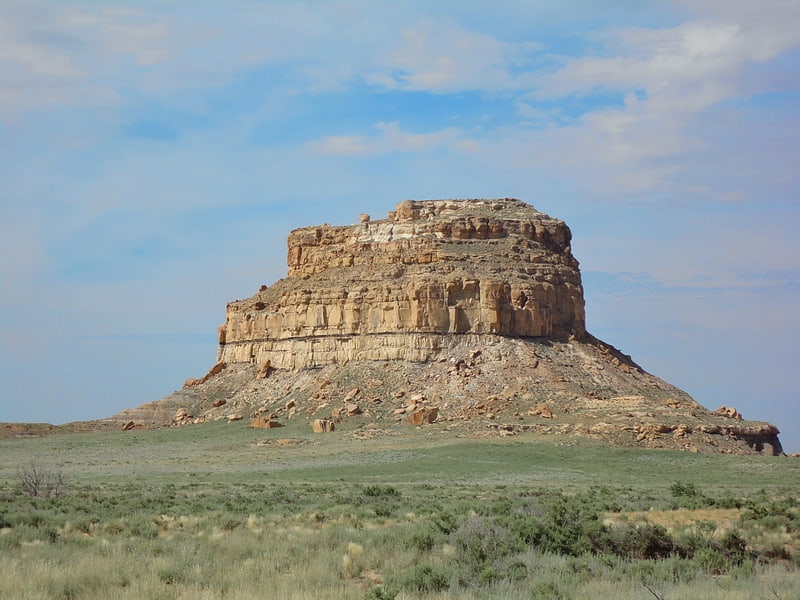
Butte in New Mexico. Fajada Butte is a butte in Chaco Culture National Historical Park, in northwest New Mexico.
Fajada Butte (Banded Butte) rises 135 meters above the canyon floor. Although there is no water source on the butte, there are ruins of small cliff dwellings in the higher regions of the butte. Analysis of fragments of pottery found on Fajada show that these structures were used between the 10th to 13th centuries.
The remains of a 95-meter-high, 230-meter-long ramp are evident on the southwestern face of the butte (Ford 1993, p. 478). The magnitude of this building project, without an apparent utilitarian purpose, indicates that Fajada Butte may have had considerable ceremonial importance for the Chacoan people.[3]
Casa Rinconada
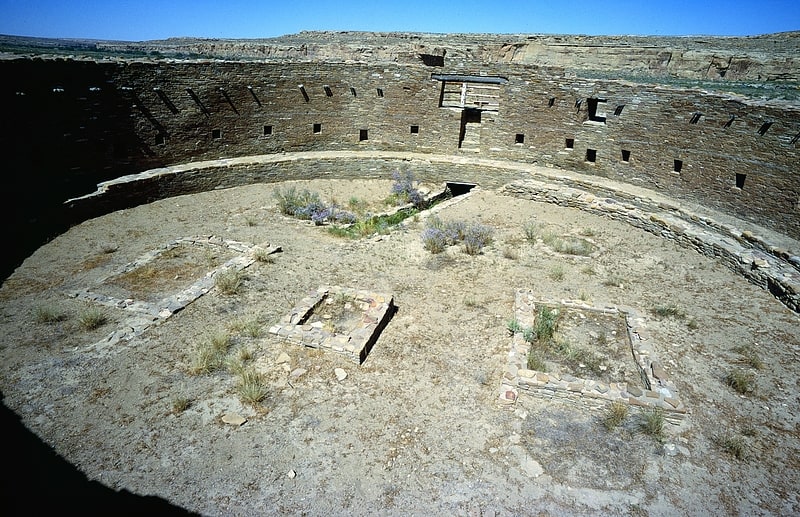
Casa Rinconada is an Ancestral Puebloan archaeological site located atop a ridge adjacent to a small rincon across from Pueblo Bonito in Chaco Culture National Historical Park, northwestern New Mexico, United States.
It is an isolated great kiva (out of four in Chaco Canyon) with all the typical elements of great kivas: a masonry firebox, an inner bench, four roof-supporting large seating pits, masonry vaults, and 34 niches, divided into two sizes, encircling the kiva. There is also an unusual 39 foot (12 m) long underground passage, perhaps used in the ceremonies to allow performers sudden entry thus surprising the audience. It was dug out of the sandstone and shale that compose the ridge on which the kiva sits.
Casa Rinconada was excavated in 1930-31 by archaeologists Vivian and Reiter and the University of New Mexico/School of American Research field schools. It was reconstructed in part by Vivian in 1933, while Richter of the National Park Service worked on capping outer walls in 1955.
Casa Rinconada is accessible through the Canyon Loop Drive and 1/2-mile (800 m) trail (round trip) off the Drive.
With a diameter of 64 feet (20 m), Casa Rinconada is the largest great kiva in Chaco Canyon.[4]
Hungo Pavi
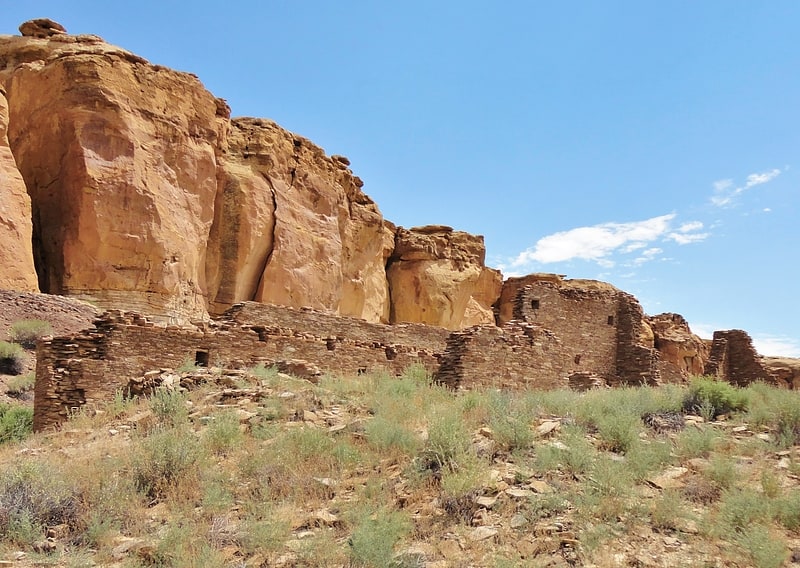
Archaeological site in San Juan County, New Mexico. Hungo Pavi is an Ancestral Puebloan great house and archaeological site located in Chaco Canyon, northwestern New Mexico, United States. A set of ruins located just 1 mile from the ruins of Una Vida, Hungo Pavi measured 872 feet in circumference. Initial explorations revealed 72 ground-level rooms, with structures reaching four stories in height. One large circular kiva has been identified. Its ruins now lie within Chaco Culture National Historical Park.[5]
Una Vida
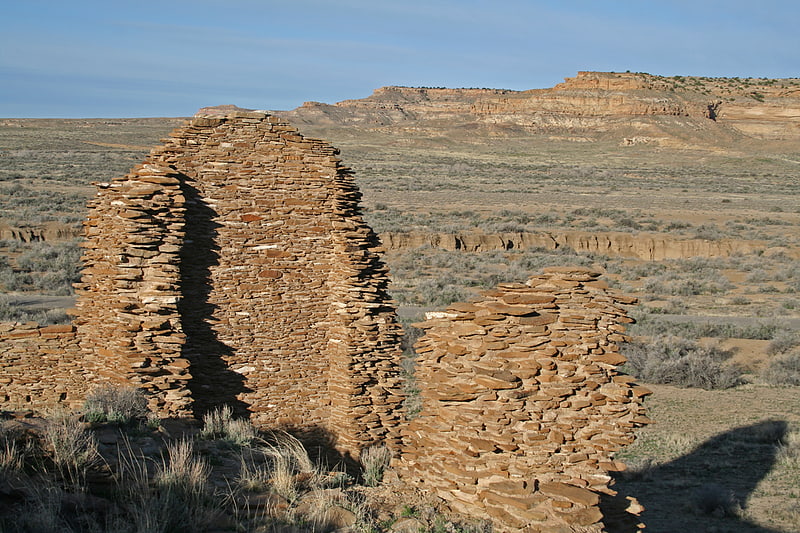
Archaeological site in San Juan County, New Mexico. Una Vida is an archaeological site located in Chaco Canyon, San Juan County, New Mexico, United States. According to tree rings surrounding the site, its construction began around 800 AD, at the same time as Pueblo Bonito, and it is one of the three earliest Chacoan Ancestral Puebloan great houses. Comprising at least two stories and 160 rooms, it shares an arc or D-shaped design with its contemporaries, Peñasco Blanco and Pueblo Bonito, but has a unique "dog leg" addition made necessary by topography. It is located in one of the canyon's major side drainages, near Gallo Wash, and was massively expanded after 930 AD.
The site is surrounded by rock art and petroglyphs that depict human figures, solar signs, and geometric forms. It was first recorded in the mid-19th century by US military that were surveying the area of modern New Mexico. The site was acquired after the war with Mexico and was only partly excavated in the 1950s and 1960s.[6]
Peñasco Blanco
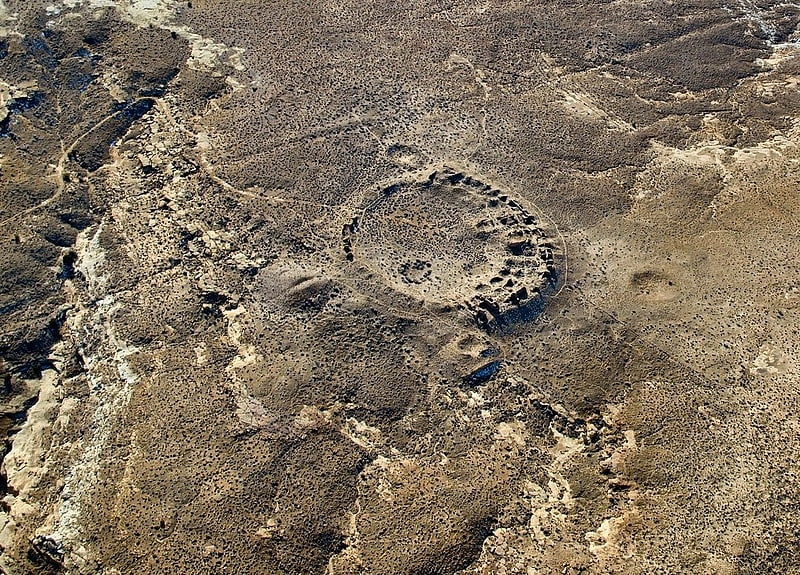
Peñasco Blanco is a Chacoan Ancestral Puebloan great house and notable archaeological site located in Chaco Canyon, a canyon in San Juan County, New Mexico, United States. The pueblo consists of an arc-shaped room block, part of an oval enclosing a plaza and great kiva, along with two great kivas outside the great house. The pueblo was built atop the canyon's southern rim to the northwest of the great houses in the main section of the canyon.
The building was constructed in five distinct stages between AD 900 and 1125, during the Pueblo III Period. A cliff painting (the "Supernova Pictograph") nearby may record the sighting of a supernova on July 5, 1054 AD.[7]
Kin Ya'a
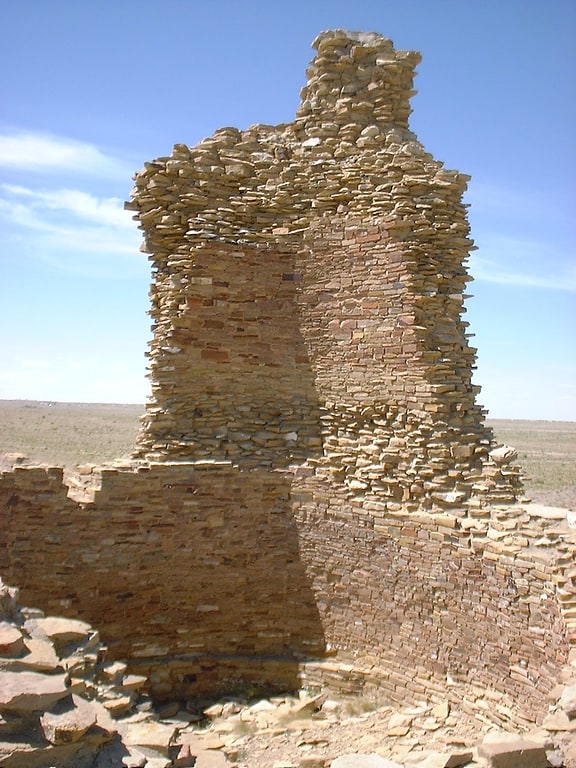
Archaeological site in McKinley County, New Mexico. Kin Ya'a is a Chacoan great house and the center of a significant Ancestral Puebloan outlier community. It is located near Crownpoint, New Mexico on the Dutton Plateau, 25 miles south of Chaco Canyon.
The unexcavated building has thirty-five rooms and four kivas, one of which is a four-story tower kiva that can be seen from several miles away. Dendrochronology indicates the structure was built during the late 11th and early 12th centuries. More than one hundred small building sites have been located within 4 square miles (10 km2). The great house is connected to Chaco Canyon by the South Road. As a detached unit of Chaco Culture National Historical Park, the site is controlled by the National Park Service.[8]
Wijiji
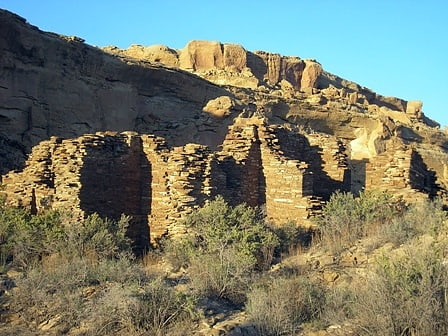
Archaeological site in San Juan County, New Mexico. Wijiji is an Ancestral Puebloan great house and archaeological site located in Chaco Canyon, in New Mexico, United States.
Comprising just over 100 rooms, it is the smallest of the Chacoan great houses. Built between AD 1110 and 1115, it was the last Chacoan great house to be constructed. Somewhat isolated within the narrow Chaco Wash, it is positioned 1 mile (1.6 km) from Una Vida.[9]
Pueblo del Arroyo

Archaeological site in San Juan County, New Mexico. Pueblo del Arroyo is an Ancestral Puebloan great house and archaeological site located in Chaco Culture National Historical Park, in New Mexico, United States.
The construction of Pueblo del Arroyo, located a few hundred yards from Pueblo Bonito, near Chaco Wash, began c. 1060 AD and continued for approximately thirty years. With three hundred rooms, it is the fourth largest great house in Chaco Canyon. Whereas the other great houses in the canyon are located near the north wall and face south, Pueblo del Arroyo was built in the middle of the canyon facing east. The structure is located opposite South Gap.
American archaeologist Neil Judd excavated Pueblo del Arroyo from 1923 to 1926, uncovering approximately half the structure. In his opinion, it was built by a group from Pueblo Bonito who moved there due to overcrowding. There are fourteen kivas at Pueblo del Arroyo, but no great kiva has been found at the site.[10]
Chaco Wash
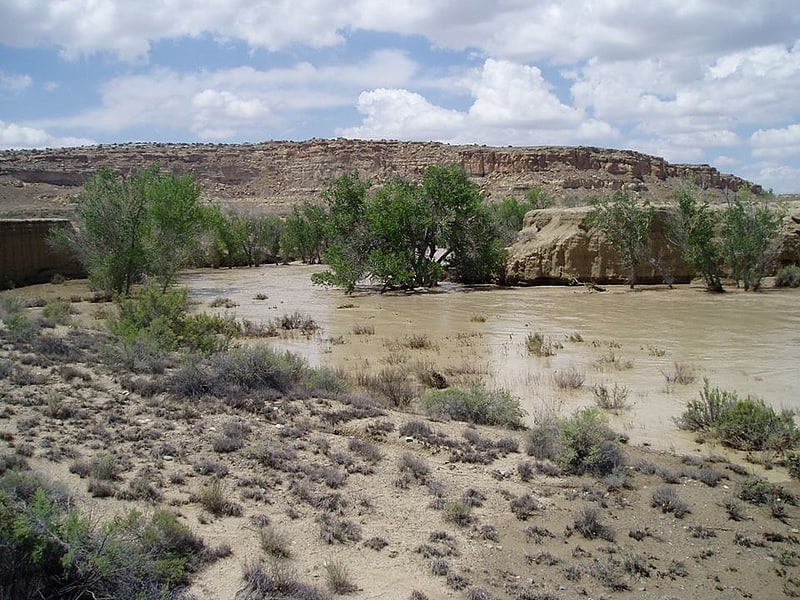
Tributary in New Mexico. The Chaco Wash is an arroyo cutting through Chaco Canyon, which is located in northwestern New Mexico on the Colorado Plateau. Another arroyo known as Escavada Wash is a tributary that feeds in from the northeast, near the western end of Chaco Canyon. Chaco Wash flows northwest to become the intermittent Chaco River. It is a tributary of the San Juan River.[11]